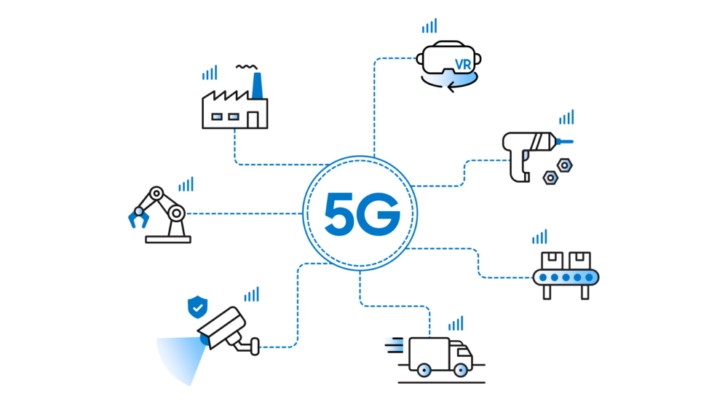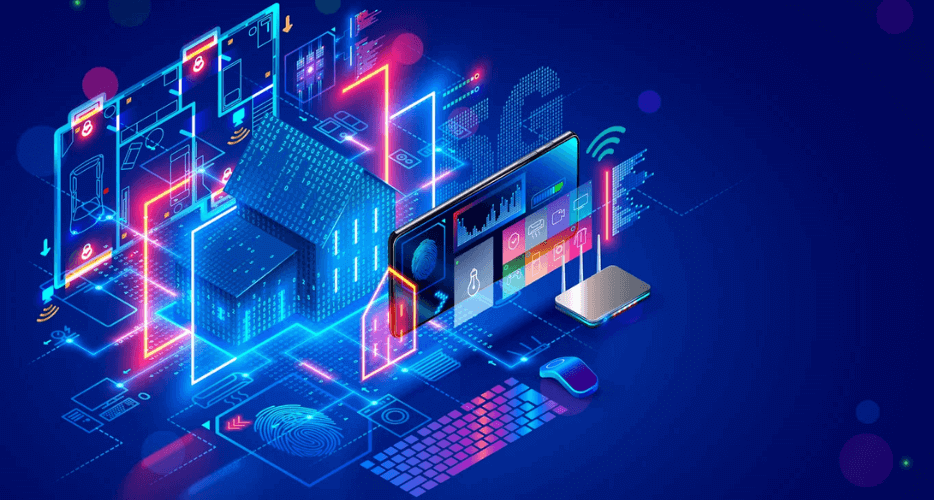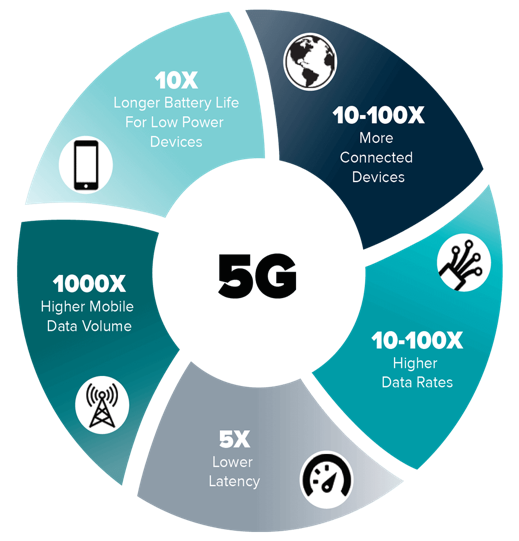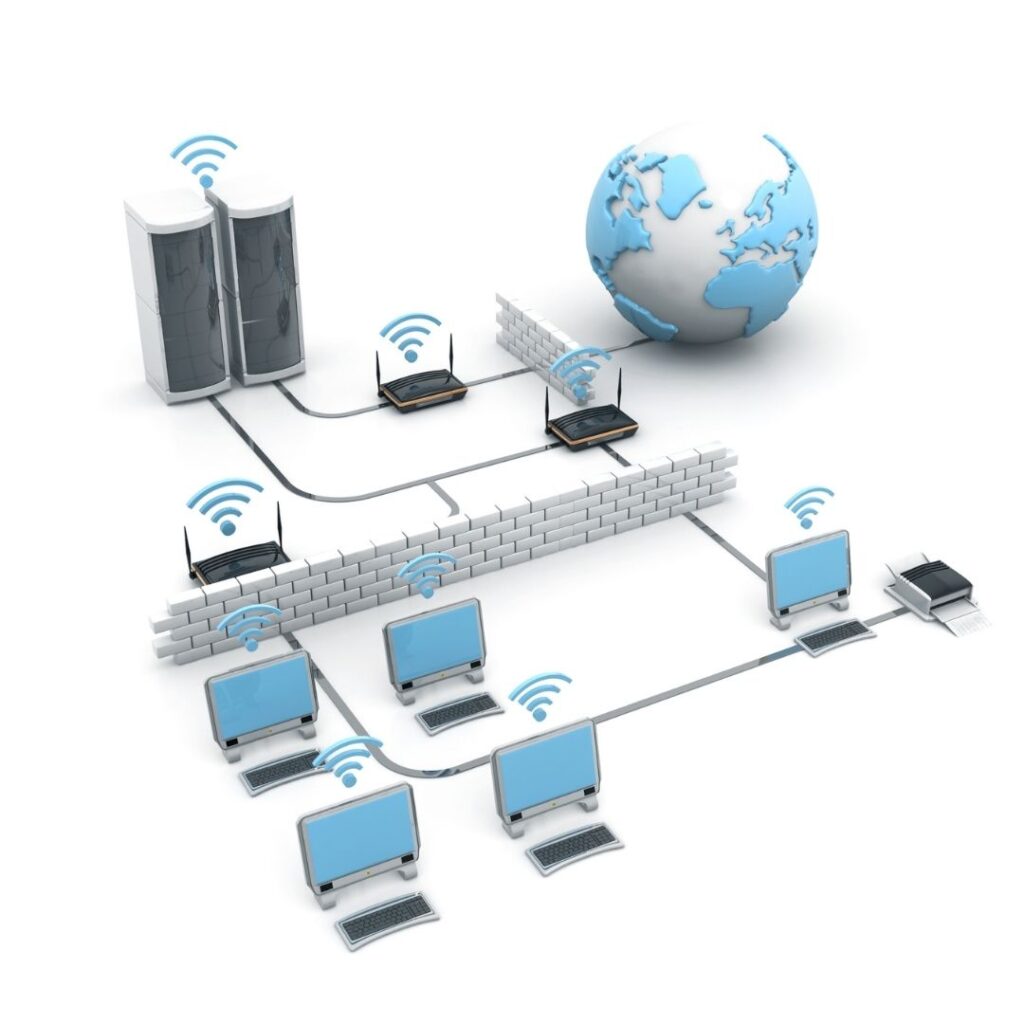Computer networks have come a long way since their beginnings, passing through various stages of evolution that have completely transformed the way we communicate and interact with technology. From the early local area networks (LANs) to the impressive capabilities of 5G networks, networking technology has marked crucial milestones that have enabled unprecedented advancements across all sectors.
In this article, we will explore how networks have evolved over time, from their humble beginnings to the era of ultra-fast connectivity and the Internet of Things (IoT) that we live in today. We will also look at the implications of this evolution on our daily lives, the impact on emerging technologies, and how businesses are leveraging these innovations to take their productivity to new levels.

The First Networks: LANs
Local Area Networks, or LANs, were one of the first forms of device interconnection and represented a revolution in the way we share information. In the 1980s, LANs began to gain popularity in offices and businesses, allowing users to share resources like printers, files, and internet access through cables.
The first LANs were simple and limited, typically using coaxial cables and Ethernet technology. These systems were not only expensive but also had relatively low data transfer speeds compared to what we consider acceptable today. However, at the time, they were an invaluable tool for business efficiency.
As LANs evolved, so did the ability to connect multiple devices through protocols like TCP/IP, making it easier to expand into more complex networks. Hardware and software innovation enabled LANs to become faster, more reliable, and, of course, more accessible to a larger number of users.
Long-Distance Connections: WANs and the Creation of the Internet
While LANs enabled communication within a single location, there was a growing need to interconnect networks across broader geographical areas. Wide Area Networks (WANs) emerged to solve this problem. Unlike LANs, WANs could cover large distances, connecting multiple offices in different locations and even countries.
This led to the birth of the Internet, a gigantic network of networks. By the mid-1990s, the Internet began to grow exponentially. It was a radical change in how people accessed information and global connectivity. Transmission technologies like fiber optics and satellite connections revolutionized the way we connected, providing much higher speeds and greater reliability.
Today, WANs and internet access allow us to stay connected at all times, regardless of distance. From accessing emails to streaming videos, WANs laid the foundation for what is now a global interconnected web of information.
Wireless Networks: Wi-Fi and Mobile Connectivity
Over time, physical networks began to be less convenient, as cables represented a limitation in both space and mobility. The need for greater flexibility and accessibility led to the development of wireless technologies that allowed users to connect without being restricted by cables. This is where Wi-Fi (Wireless Fidelity) emerged, enabling internet connection in offices, homes, and public spaces without the need for cables.
Since its standardization in 1997, Wi-Fi has rapidly evolved, increasing its speed and reliability with each new version. The transition from Wi-Fi 802.11b to more advanced versions like 802.11ac and 802.11ax (Wi-Fi 6) has allowed much faster data transfer speeds and greater efficiency in environments with many connected devices.
At the same time, mobile connectivity also began to take off, pushing the concept of wireless networks one step further. Starting in the 2000s, 2G, 3G, and 4G networks made it possible to connect mobile devices anywhere in the world, forever changing the way we use smartphones, tablets, and other connected devices. 3G networks brought web browsing capabilities, while 4G enabled high-definition video streaming and more stable, faster connectivity for more demanding applications.
Wireless and mobile networks gave users the freedom to connect from anywhere, increasing the demand for on-the-go internet and facilitating the mass adoption of smart devices.
The Latency Challenge: From 4G to 5G
While 4G networks marked a major milestone in terms of speed and connectivity, there was still a significant challenge: latency. Latency is the time it takes for data to be transmitted from one device to another, and in some cases, the latency in 4G networks was still a hindrance for more demanding applications like real-time online gaming, augmented reality (AR), and virtual reality (VR).
To overcome this challenge, the 5G network was born, promising to revolutionize communications once again. 5G not only provides much faster speeds than 4G, but it also reduces latency to almost nonexistent levels. This opens the door to new applications, such as autonomous driving, where real-time communication is crucial for safety and performance.
5G technology also relies on a greater density of connected devices, which is essential for the development of the Internet of Things (IoT), allowing billions of smart devices to connect in homes, industries, and cities. 5G not only improves speed but also offers much greater capacity to support a large number of devices simultaneously, enabling seamless connectivity in heavily congested areas such as stadiums or densely populated urban centers.
The Impact of 5G: Ultra-Fast Connectivity and New Possibilities
5G is not only changing the way we connect but also how we interact with emerging technologies. For example, in the field of healthcare, 5G will allow the real-time transmission of medical data, facilitating remote patient care through connected medical devices. In education, high-speed connectivity will enable immersive learning experiences through virtual reality, radically changing the way students interact with educational content.
Smart cities are also benefiting greatly from 5G, as ultra-fast, low-latency networks will allow for more efficient traffic, energy, and public resource management. Autonomous transport systems and connected infrastructure will be made possible by 5G’s ability to provide real-time communication between vehicles and devices within the city.
The applications of 5G go beyond what we can imagine, from improving online gaming experiences to creating new ways for people and machines to interact. In the coming years, the adoption of 5G will further change how we interact with technology and with each other.
The Internet of Things (IoT) and the Connected Revolution
One of the most significant advances enabled by 5G technology is the Internet of Things (IoT). This concept, which refers to the interconnection of physical devices via the network, has completely changed the way we interact with our environment. If you’ve ever used a smart thermostat, a connected lamp, or a wearable device that collects data about your health, you are already part of the IoT.
The IoT has grown at a rapid pace, and it is estimated that by 2025, there will be more than 41 billion connected devices worldwide. This includes not only household appliances and personal devices but also infrastructure systems, vehicles, and industrial machinery. Thanks to 5G, the number of connected devices simultaneously has increased exponentially, making IoT much more efficient and accessible.
5G networks are essential for the IoT because they provide the speed, capacity, and low latency necessary for these devices to interact in real time. Instead of relying on Wi-Fi or 4G networks, which can become overloaded in high-demand areas, 5G offers a much more efficient and scalable solution. This will allow smart cities, connected homes, and automated factories to become increasingly common, transforming not only our daily lives but also how businesses operate.
Real-Time Communication: Virtual Reality (VR) and Augmented Reality (AR)

The low latency and increased bandwidth provided by 5G are also opening up new opportunities for real-time applications such as Virtual Reality (VR) and Augmented Reality (AR). These technologies, which once required specialized hardware and limited connections, are now beginning to integrate more seamlessly into our everyday lives.
In VR, for example, the ability to interact with virtual worlds immersively and in real time heavily depends on connectivity. With 5G, gaming, training simulations, and educational experiences become much more realistic and fluid. The low latency is crucial for user movements to be reflected instantly in the virtual world, eliminating delays that could break the experience.
On the other hand, AR has the potential to transform sectors such as education, healthcare, retail, and manufacturing. AR devices allow digital information to be overlaid on the real world, and with 5G, the experience becomes more accurate and natural. Imagine using AR glasses to receive real-time instructions while assembling a product, or getting instant medical diagnostics during a remote consultation.
These technologies are made possible by 5G’s speed and ability to handle large volumes of data in real time, which enables the integration of augmented and virtual reality into a wide range of applications.
Digital Transformation in Businesses: From Cloud to Edge Computing
Another key change driven by 5G networks is the digital transformation in the business world. In an increasingly globalized business environment, companies depend on connectivity to operate efficiently. 5G is revolutionizing how businesses use cloud computing and is giving rise to edge computing, a technology that processes data closer to its source, rather than relying solely on remote servers.
Cloud computing has allowed businesses to store and process large volumes of data more efficiently, but the need for instant, real-time access to data has driven the adoption of edge computing. With 5G, devices and sensors can process data locally, reducing latency and improving operational efficiency.
This has applications across various sectors. In manufacturing, for example, IoT devices can monitor machinery in real time, allowing for the prediction of failures before they occur and optimizing production processes. In logistics, companies can track the movement of their products and optimize delivery routes, reducing costs and improving customer experience.
The ability of 5G to connect these devices more quickly and efficiently is allowing businesses to move from being reactive players to proactive ones, anticipating needs and continually improving their operations.
The Future of Networks: Towards 6G and Beyond
While 5G is transforming how we connect, discussions about the future of networks have already begun: 6G. Although still in its early development stages, 6G is expected to surpass the capabilities of 5G in terms of speed, capacity, and latency. 6G networks will likely enable even more impressive advancements in areas such as artificial intelligence (AI), quantum devices, and global connectivity.
In the near future, 6G will not only be faster and more reliable but will also allow networks to become even smarter, anticipating our needs before we express them. With more advanced infrastructure, devices will be even more connected, and the user experience will be almost perfect, with no interruptions or latency.
5G Networks in the Real World: Use Cases and Applications
Now that we’ve covered the fundamental advancements of 5G networks, it’s important to explore how this technology is being applied in the real world. From industrial automation to entertainment, 5G networks are enabling innovations that once seemed straight out of a science fiction movie. Below are some use cases that demonstrate the true potential of 5G networks.

1. Smart Cities: Transforming Urban Life
One of the most exciting use cases for 5G is the creation of smart cities, where urban infrastructure, transportation, and public services are connected and managed through advanced network technologies. With 5G, devices and sensors in the city can communicate instantly to optimize traffic flow, improve waste management, monitor air quality, and provide more efficient services.
For example, autonomous vehicles are one of the most advanced applications enabled by 5G. Thanks to the low latency of the network, autonomous vehicles can make real-time decisions based on data from other vehicles and urban infrastructure. This will not only make transportation safer and more efficient but will also reduce traffic congestion and harmful emissions.
Smart cities will also benefit from more efficient resource management, such as water and energy. Sensors connected to the 5G network can track the consumption of these resources in real time, allowing for instant adjustments to reduce waste and improve sustainability.
2. Telemedicine: Remote Healthcare in Real Time
Telemedicine has been a significant topic in recent years, and 5G’s arrival is taking this field to new heights. With 5G, online medical consultations will not only be faster and more reliable but will also allow for greater integration of connected medical devices.
For example, remote monitoring devices that measure vital signs such as blood pressure, blood glucose, or heart rate will be able to transmit data in real time to healthcare professionals. This will not only improve the quality of healthcare but also allow patients to receive personalized treatments without leaving their homes.
Additionally, tele-surgery is one of the most promising applications of 5G. With the ability to transmit high-resolution images and real-time data with almost zero latency, surgeons can operate remotely with precise, real-time control. This could save lives in remote areas or enable collaboration between medical experts from different parts of the world.
3. Immersive Entertainment: The Future of Gaming and Streaming
Entertainment is also experiencing a transformation driven by 5G networks. The low latency and increased bandwidth of 5G allow for more immersive and higher-quality experiences in gaming and content streaming.
For gaming, 5G is enabling cloud gaming without the need for a powerful console. By being able to transmit high-quality graphics in real time, 5G allows complex titles to be played on mobile devices or PCs with moderate specifications, opening access to a much larger audience.
Moreover, 4K and 8K streaming services will benefit greatly from 5G. Faster connections allow users to enjoy ultra-high-definition content without interruptions, even on mobile devices. This will change the way we consume entertainment, offering a richer and smoother experience.
Challenges and Opportunities: What Lies Ahead with 5G?
Despite its incredible advantages, the implementation of 5G networks is not without challenges. One of the biggest obstacles is the infrastructure needed to support the high speeds and low latency that 5G promises. Unlike previous networks, 5G requires more antennas and base stations to adequately cover large areas, especially in densely populated urban environments.
This requires significant investment from telecommunications operators and governments. However, in the long run, the benefits of ultra-fast connectivity are worth it, as 5G networks have the potential to generate billions of dollars in new business opportunities.
Another important challenge is security. As more devices connect to the network, the attack surface for cybercriminals increases. Protecting personal and business data will be critical, and new cybersecurity solutions will be needed to ensure that 5G networks are safe and reliable.
Nevertheless, the opportunities that 5G brings are enormous. From boosting business productivity to creating new ways of social and work interaction, 5G is poised to transform society as a whole. As more businesses and users adopt this technology, the possibilities for innovation will continue to grow, changing the way we work, play, and connect.

The Future of Networks Is Here
The evolution of networks has been a fascinating journey, from the early LANs to the innovative 5G networks. Each step has allowed advances in the way we communicate, share information, and access technology. Today, 5G networks are marking a milestone in connectivity, opening doors to a future full of new possibilities.
Whether in the creation of smart cities, improving healthcare, transforming entertainment, or driving business innovation, 5G has the potential to change the world as we know it. As we continue to move forward into the future, it is exciting to think about what the next generation of networks will bring.



